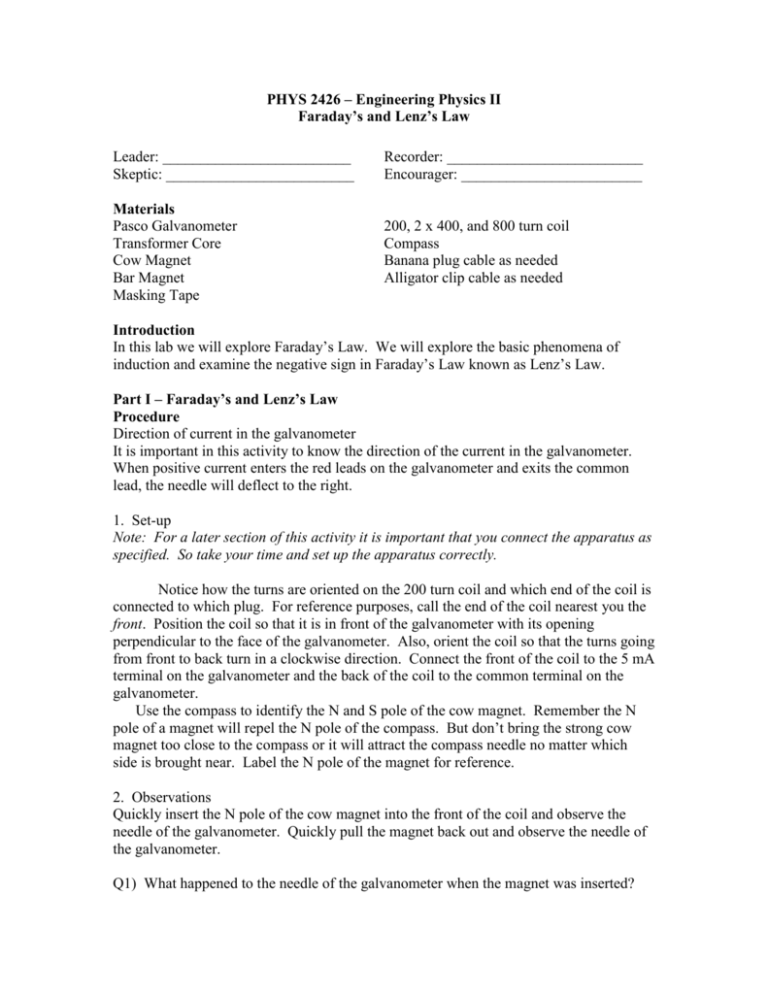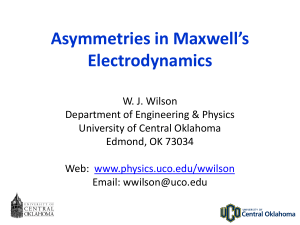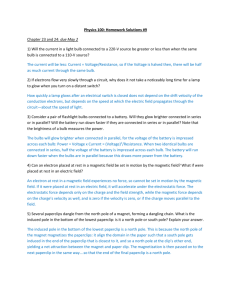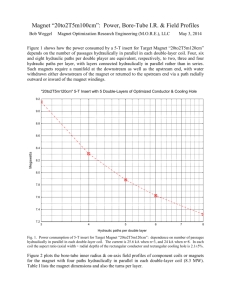PHYS 2426 * Engineering Physics II
advertisement

PHYS 2426 – Engineering Physics II Faraday’s and Lenz’s Law Leader: _________________________ Skeptic: _________________________ Recorder: __________________________ Encourager: ________________________ Materials Pasco Galvanometer Transformer Core Cow Magnet Bar Magnet Masking Tape 200, 2 x 400, and 800 turn coil Compass Banana plug cable as needed Alligator clip cable as needed Introduction In this lab we will explore Faraday’s Law. We will explore the basic phenomena of induction and examine the negative sign in Faraday’s Law known as Lenz’s Law. Part I – Faraday’s and Lenz’s Law Procedure Direction of current in the galvanometer It is important in this activity to know the direction of the current in the galvanometer. When positive current enters the red leads on the galvanometer and exits the common lead, the needle will deflect to the right. 1. Set-up Note: For a later section of this activity it is important that you connect the apparatus as specified. So take your time and set up the apparatus correctly. Notice how the turns are oriented on the 200 turn coil and which end of the coil is connected to which plug. For reference purposes, call the end of the coil nearest you the front. Position the coil so that it is in front of the galvanometer with its opening perpendicular to the face of the galvanometer. Also, orient the coil so that the turns going from front to back turn in a clockwise direction. Connect the front of the coil to the 5 mA terminal on the galvanometer and the back of the coil to the common terminal on the galvanometer. Use the compass to identify the N and S pole of the cow magnet. Remember the N pole of a magnet will repel the N pole of the compass. But don’t bring the strong cow magnet too close to the compass or it will attract the compass needle no matter which side is brought near. Label the N pole of the magnet for reference. 2. Observations Quickly insert the N pole of the cow magnet into the front of the coil and observe the needle of the galvanometer. Quickly pull the magnet back out and observe the needle of the galvanometer. Q1) What happened to the needle of the galvanometer when the magnet was inserted? Q2) What happened to the needle of the galvanometer when the magnet was pulled back out? Reverse the direction of the magnet and try again. Q3) Did you see any difference when you reversed the orientation of the magnet. Repeat your observations for both orientations on the other side of the coil and summarize your results in the table below. You should have a total of 8 observations. Leave the last two columns blank for now. Side of Solenoid (Front or Back) Pole (N or S) Direction of Magnet (into or out of the solenoid) Direction of Needle on Galvanometer (R or L) Sign of current (+/-) Induced Pole (N/S) Q4) List the cases where the galvanometer needle deflected to the left and to the right in the space below. Q5) Sketch diagrams for the cases where the galvanometer needle deflected to the left. Be sure to indicate the orientation of the magnetic field and the direction of travel of the magnet. Use your diagrams to explain how the situations that produced a deflection to the left are similar. Q6) Sketch diagrams for the cases where the galvanometer needle deflected to the right. Be sure to indicate the orientation of the magnetic field and the direction of travel of the magnet. Use your diagrams to explain how the situations that produced a deflection to the right are similar. Q7) If the magnet just sits inside the coil, do you see any deflection of the galvanometer? Q8) What is happening to the magnetic field in the coil when you do see a deflection of the galvanometer needle? Question 8 is the essence of Faraday's law and why it was so difficult for Faraday to find it. In his experiments Faraday had used steady magnetic fields to try and produce a current, but it is a changing magnetic field that produces a current. Lenz's Law You should have noticed that there is a pattern when the deflection of the needle of the galvanometer is to the left or the right. The result is known as Lenz's law. Identify the terminals labeled + and – on the galvanometer. When a positive current flows into the terminal labeled +, it will produce a deflection of the galvanometer needle to the right. Identify for each of your observations whether the current is + or – and fill in the column of the table above for the sign of the current. Q9) When you insert the magnet in the coil you produce a current. What does a current in a coil produce? Q10) Use the direction of current flow in the coil and your right hand rule for a solenoid to determine the direction of the magnetic field induced by the current for each of the eight observations you made above. For each of the 8 cases, label the pole induced on the side of the coil where the magnet is being moved in the last column of the table above. Q11) In all cases when you inserted a N pole, what pole was induced on the side where you inserted a N pole? Q12) Would the induced pole try to attract or repel the inserted N pole? Q13) In all cases when you removed a N pole, what pole was induced on the side where you removed a N pole? Q14) Would the induced pole try to attract or repel the removed N pole? Q15) In all cases when you inserted a S pole, what pole was induced on the side where you inserted a S pole? Q16) Would the induced pole try to attract or repel the inserted S pole? Q17) In all cases when you removed a S pole, what pole was induced on the side where you removed a S pole? Q18) Would the induced pole try to attract or repel the removed S pole? Q19) Note that whenever you inserted a pole a like/opposite (circle one) pole was induced, which would attract/repel (circle one) the inserted pole. Q19) Note that whenever you removed a pole a like/opposite (circle one) pole was induced, which would attract/repel (circle one) the removed pole. Q20) Lenz's law is the observation of how the direction of the induced field compares to the direction of the inducing field. The directions are _____________. Magnetic Flux So far we have only investigated a single magnet and coil. Let us investigate other factors that might affect the induced current. Q21) Try a weaker magnet such as the provided bar magnet. How does the strength of the deflection compare when the bar magnet is inserted compared to when the cow magnet is inserted? Q22) Connect a coil with 400 turns. Try again with the cow magnet. How does the effect compare? Q23) Connect a coil with 800 turns. Try again with the cow magnet. How does the effect compare? Use the alligator clip wire to make a coil with 10 turns and connect it to the galvanometer. Insert the cow magnet and note the size of the effect. Wrap a coil again with 10 turns only make the radius of the coil half as big. Insert the magnet and note the size of the effect. Q24) How did the effect compare when the coil had half the radius? (Note: It can be difficult to see a difference.) You should have observed that the induced current was smaller if the magnet was weaker, the number of turns was less and the area was smaller. This combination of variables produces what is called the magnetic flux. The magnetic flux through a single coil is defined as B = BnA, where n is a unit vector perpendicular to the area. Remember that a dot product is defined as BnA = BA cos. If the magnetic field goes through N coils, then the total flux is simply tot = NB . When you insert the magnet into the coil, you change the flux because you change the magnetic field. Q25) Are there any other ways to change the flux? Q27) Try connecting a single piece of flexible wire across the terminals of the galvanometer. Wrap three or four turns loosely around one end of the magnet. Rapidly pull the ends of the wire so that you collapse the coil. Do you observe an effect? (Note you will need to observe very carefully.) Q28) In Q27 we saw that we could induce a current by changing the area. However what are we actually producing when we change the flux? Find the SI units of dB /dt. What kind of quantity has these units? Hint: what do you need to produce a current? You should have found in Q28) that the units of the rate of change of magnetic flux are V, so we can sum up Faraday's law as the following: dB /dt = -E, where we have denoted – as is customary – the induced potential by E for EMF. The – sign in Faraday's law is Lenz's law. It means that the induced voltage is such as to try and oppose the change in magnetic flex. Q29) Faraday's law can be summed up as A _______________ magnetic flux induces a/an ________________________, which __________________ the change.








